语言学教程[第十一章语言学与语言教学]山东大学期末考试知识点复习
语言学教程[第一章语言学导论]山东大学期末考试知识点复习
![语言学教程[第一章语言学导论]山东大学期末考试知识点复习](https://img.taocdn.com/s3/m/b476bb6000f69e3143323968011ca300a6c3f6d3.png)
语言学教程[第一章语言学导论]山东大学期末考试知识点复习第一章语言学导论复习笔记Ⅰ.语言的定义语言是人类以口头交流的任意的符号系统。
该定义揭示了语言的五个要素:系统,任意,口头,符号,人类。
Ⅱ.语言的定义特征语言的定义特征是人类语言区别于其他动物交流系统的特点。
1.任意性二重性是指拥有两层结构的这种属性,底层结构是上层结构的组成成分,每层都有自身的组合规则。
二重性只存在于这样的系统之中,既有元素又有它们组合成的单位。
3.创造性创造性指语言的能产性,它能够使人造出和理解无穷的长句,其中很多句子是以前从未听过的。
4.移位性移位性是指人类语言可以让使用者在交际时用语言符号代表时间上和空间上并不可及的物体、事件和观点。
移位性赋予人们的概括和想象力使人类受益无穷。
5.文化传递性语言不是靠遗传,而是通过文化传递的。
6.互换性互换性是指人可以是信息的发出者,也可以是信息的接受者,即人作为说话者和听话者的角色是可以随意更换的。
Ⅲ.语言的起源1.圣经的记载语言是上帝的恩赐。
2.“汪汪”理论语言是模仿自然的声音,例如动物的叫声,如(鸭子)的刮刮声,嘎嘎声,布谷鸟的叫声。
3.“噗噗”理论语言起源于原始人共同劳动时发出的有节奏的哼哟声。
5.进化理论语言起源于劳动的过程,满足了社会的需求。
Ⅳ.语言的功能1.信息功能语言用来陈述某件事情,提供信息或用作推理。
信息功能是语言最重要的功能,一般出现在陈述句中。
2.人际功能人际功能是语言最重要的社会功能。
人们由此建立和维持他们的身份和社会地位。
3.施为功能语言的施为功能主要是用来改变人的社会地位,例如在婚礼、判刑,为孩子祈福和在首航仪式上为船命名、诅咒敌人。
在这些言语行为中,语言通常是非常正式的,甚至是仪式化的。
4.感情功能语言的感情功能是语言最有用的功能之一,因为它在改变听者赞成或反对某人、某物的态度上作用非常关键。
5.寒暄功能寒暄功能是指那些有助于确立和维持人际关系的表达,例如俚语、玩笑、行话、礼节性的问候、社会方言或地域方言的转用等。
胡壮麟《语言学教程》章节题库(语言学与语言教学)【圣才出品】
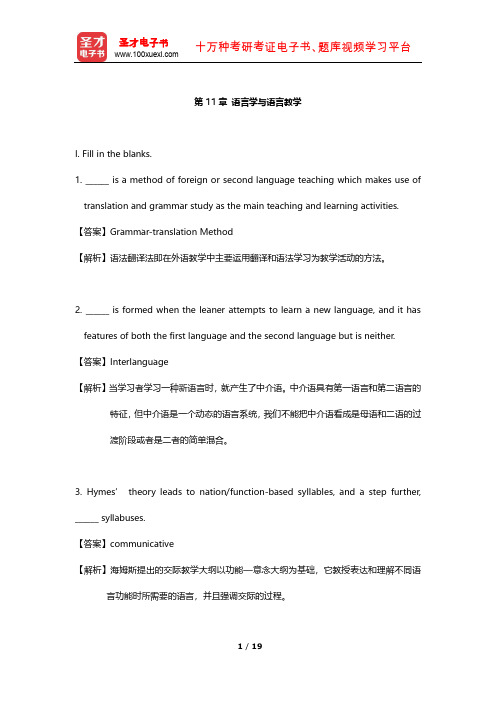
第11章语言学与语言教学I. Fill in the blanks.1. ______ is a method of foreign or second language teaching which makes use of translation and grammar study as the main teaching and learning activities. 【答案】Grammar-translation Method【解析】语法翻译法即在外语教学中主要运用翻译和语法学习为教学活动的方法。
2. ______ is formed when the leaner attempts to learn a new language, and it has features of both the first language and the second language but is neither.【答案】Interlanguage【解析】当学习者学习一种新语言时,就产生了中介语。
中介语具有第一语言和第二语言的特征,但中介语是一个动态的语言系统,我们不能把中介语看成是母语和二语的过渡阶段或者是二者的简单混合。
3. Hymes’theory leads to nation/function-based syllables, and a step further, ______ syllabuses.【答案】communicative【解析】海姆斯提出的交际教学大纲以功能—意念大纲为基础,它教授表达和理解不同语言功能时所需要的语言,并且强调交际的过程。
4. Error is the grammatically incorrect form; ______ appears when the language is correct grammatically but improper in a communicational context.【答案】mistake【解析】错误通常指由于学习者不知道正确的形式或者不能正确地使用语言而出现的错误。
《语言学教程》中文笔记(完整)

语言学教程笔记第一章语言学导论语言的定义特征:从本质上将人类语言与动物语言区分开的人类语言的区别性特点。
1.任意性:任意性是指语言符号的形式与所表示的意义没有天然的联系,任意性是语言的核心特征。
例如,我们无法解释为什么一本书读作a /buk/,一支钢笔读作a /pen/。
任意性具有不同层次:(1)语素音义关系的任意性。
(2)句法层面上的任意性。
(3)任意性和规约性。
2.二层性:二层性是指拥有两层结构的这种特性,上层结构的单位由底层结构的元素构成,每层都有自身的组合规则。
话语的组成元素是本身不传达意义的语音,语音的唯一作用就是相互组合构成有意义的单位,比如词。
因为底层单位是无意的,而上层单位有明确的意义,所以我们把语音叫做底层单位,与词等上层单位相对。
二层性使语言拥有了一种强大的能产性。
3.创造性:创造性指语言的能产性,指语言有制造无穷长句的潜力,这来源于语言的二层性和递归性。
利用二重性说话者可以通过组合基本语言单位,无止境地生成句子,大多数都是以前没有过的或没有听过的。
4.移位性:是指人类语言可以让使用者在交际时用语言符号代表时间上和空间上并不可及的物体、时间或观点。
因此我们可以提及孔子或北极,虽然前者已经去世两千五百五十多年而后者位置距我们非常之远。
语言使我们能够谈及已不存在或还未出现的事物。
移位性赋予人们的概括与抽象能力使人类受益无穷。
词在指称具体物体时,并不总是出现在即时、形象化的语境中。
他们通常为了体现指称含义而被使用。
5.文化传递性:语言不是靠遗传,而是通过文化传递的。
6.互换性:指人可以是信息的发出者,也可以是信息的接受者,即人作为说话者和听话者的角色是可以随意更换的。
元语言功能:我们的语言可以用来讨论语言本身。
比如说,我可以用“书”指代一本书,也可以用“书这个词”来指代“书”这个词本身。
这使语言具有无限的自我反身性:人类可以谈论“说话”,也可以思考“思考”。
所以只有人类才能提问:元语言功能对交际、思考及人类的意义是什么?语言学的一些重要区别1.“描写式”和“规范式”描写式:客观系统地记录一种语言的模式和用法或变化。
语言学基础期末复习提纲(整理版)
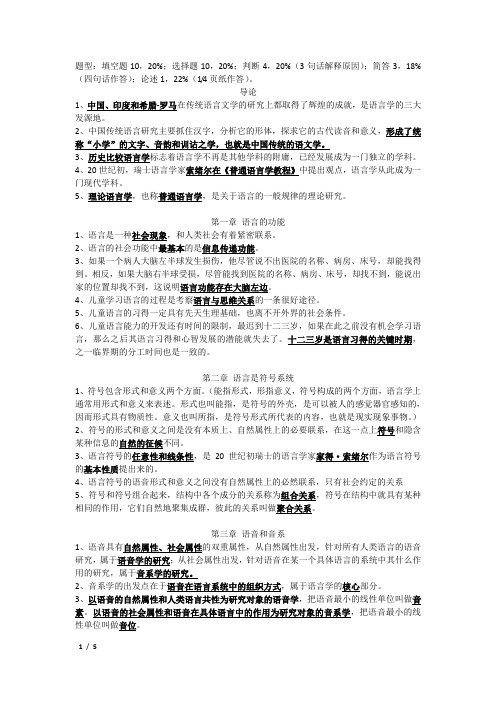
题型:填空题10,20%;选择题10,20%;判断4,20%(3句话解释原因);简答3,18%(四句话作答);论述1,22%(1/4页纸作答)。
导论1、中国、印度和希腊-罗马在传统语言文学的研究上都取得了辉煌的成就,是语言学的三大发源地。
2、中国传统语言研究主要抓住汉字,分析它的形体,探求它的古代读音和意义,形成了统称“小学”的文字、音韵和训诂之学,也就是中国传统的语文学。
3、历史比较语言学标志着语言学不再是其他学科的附庸,已经发展成为一门独立的学科。
4、20世纪初,瑞士语言学家索绪尔在《普通语言学教程》中提出观点,语言学从此成为一门现代学科。
5、理论语言学,也称普通语言学,是关于语言的一般规律的理论研究。
第一章语言的功能1、语言是一种社会现象,和人类社会有着紧密联系。
2、语言的社会功能中最基本的是信息传递功能。
3、如果一个病人大脑左半球发生损伤,他尽管说不出医院的名称、病房、床号,却能找得到。
相反,如果大脑右半球受损,尽管能找到医院的名称、病房、床号,却找不到,能说出家的位置却找不到,这说明语言功能存在大脑左边。
4、儿童学习语言的过程是考察语言与思维关系的一条很好途径。
5、儿童语言的习得一定具有先天生理基础,也离不开外界的社会条件。
6、儿童语言能力的开发还有时间的限制,最迟到十二三岁,如果在此之前没有机会学习语言,那么之后其语言习得和心智发展的潜能就失去了。
十二三岁是语言习得的关键时期,之一临界期的分工时间也是一致的。
第二章语言是符号系统1、符号包含形式和意义两个方面。
(能指形式,形指意义,符号构成的两个方面,语言学上通常用形式和意义来表述。
形式也叫能指,是符号的外壳,是可以被人的感觉器官感知的,因而形式具有物质性。
意义也叫所指,是符号形式所代表的内容,也就是现实现象事物。
)2、符号的形式和意义之间是没有本质上、自然属性上的必要联系,在这一点上符号和隐含某种信息的自然的征候不同。
3、语言符号的任意性和线条性,是20世纪初瑞士的语言学家家得·索绪尔作为语言符号的基本性质提出来的。
语言学教程[第十一章语言学与语言教学]山东大学期末考试知识点复习-推荐下载
![语言学教程[第十一章语言学与语言教学]山东大学期末考试知识点复习-推荐下载](https://img.taocdn.com/s3/m/51e8628503d8ce2f006623ed.png)
第十一章语言学与语言教学复习笔记I.应用语言学的定义从广义上讲,应用语言学是对语言、语言学与语言相关的问题的研究,例如词典编纂学,翻译等。
应用语言学运用来自语言学的信息来发展它自身理论模块部分,例如教学大纲设计,言语治疗,语言规划,文体学等。
从狭义上讲,应用语言学是指对第二语言和语言教学的研究,例如研究语言和语言学与语言教学的关系。
II.语言学与语言教学的关系语言教学是应用语言学的一个部分,而应用语言学又是语言学的一个分支。
掌握一些语言学的知识不仅有助于这些读者进一步认识语言本质,也有助于他们更加深入地理解如何教好语言。
语言学理论直接地或间接地影响着语言教学的途径和方法。
Ⅲ.语言学与语言学习许多语言学习理论都是基于某种语言学理论提出的。
事实上,语言学知识能够使我们真正理解学习者能够学习什么样的语言,怎样学习语言以及最终能够学到什么。
因此,语言学在语言习得研究和语言学习研究中一直起着十分重要的作用。
1.语法与语言学习很多传统的语言教师将语法割裂为孤立的语法知识点来分别讲解,这种做法已经受到广泛的批评,因为它仅仅关注语言形式而忽略了语言的意义。
作为“完全以语言形式为中心”和“完全以语言意义为中心”的折中途径,近年来出现的“关注语言形式” (focus on form)对语言学习中语法的作用采取了一种折中的态度。
主要有两个变量影响语言成分在“关注语言形式”中的顺从性,即普遍语法(UG)的相关度和语言结构的复杂度。
“关注语言形式”的支持者们认为,如果二语中的某个结构是普遍语法的一部分,它的顺从性就高;否则,顺从性则低。
在“关注语言形式”的教学中,我们会根据语言结构顺从性的高与低来采取不同的措施。
2.输入和语言学习当学习者接受了足够的目的语输入时,语言学习自然而然就会发生。
输入可以是口头语言,也可以是书面语言。
口头语言输入可能发生在交互活动中(即如学习者与母语者、教师或者是其他学习者的对话),或者出现一个没有交互的语境中 (例如听音乐或者看电影)。
胡壮麟《语言学教程》(第5版)笔记和考研真题详解
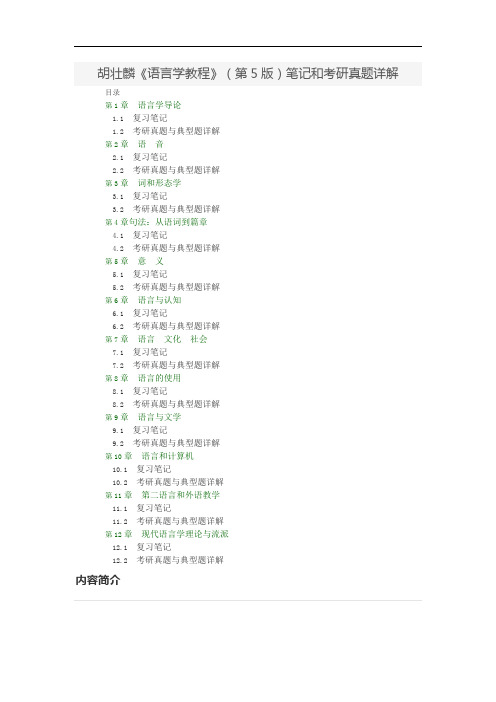
胡壮麟《语言学教程》(第5版)笔记和考研真题详解目录第1章语言学导论1.1复习笔记1.2考研真题与典型题详解第2章语音2.1复习笔记2.2考研真题与典型题详解第3章词和形态学3.1复习笔记3.2考研真题与典型题详解第4章句法:从语词到篇章4.1复习笔记4.2考研真题与典型题详解第5章意义5.1复习笔记5.2考研真题与典型题详解第6章语言与认知6.1复习笔记6.2考研真题与典型题详解第7章语言文化社会7.1复习笔记7.2考研真题与典型题详解第8章语言的使用8.1复习笔记8.2考研真题与典型题详解第9章语言与文学9.1复习笔记9.2考研真题与典型题详解第10章语言和计算机10.1复习笔记10.2考研真题与典型题详解第11章第二语言和外语教学11.1复习笔记11.2考研真题与典型题详解第12章现代语言学理论与流派12.1复习笔记12.2考研真题与典型题详解内容简介作为《语言学教程》(第5版)(胡壮麟主编,北京大学出版社)的学习辅导书,全书完全遵循该教材的章目编排,共分12章,每章由两部分组成:第一部分为复习笔记(中英文对照),总结本章的重点难点;第二部分是考研真题与典型题详解,精选名校经典考研真题及相关习题,并提供了详细的参考答案。
本书具有以下几个方面的特点:1.梳理章节脉络,浓缩内容精华。
每章的复习笔记以该教材为主并结合其他教材对本章的重难点知识进行了整理,并参考了国内名校名师讲授该教材的课堂笔记,因此,本书的内容几乎浓缩了经典教材的知识精华。
2.中英双语对照,凸显难点要点。
本书章节笔记采用了中英文对照的形式,强化对重要难点知识的理解和运用。
3.精选考研真题,补充难点习题。
本书精选名校考研真题及相关习题,并提供答案和详解。
所选真题和习题基本体现了各个章节的考点和难点,但又不完全局限于教材内容,是对教材内容极好的补充。
另外,在笔记部分,对于在《语言学教程》第三版或第四版提到而第五版删减的知识点我们也予以保留,并用“*”标明,部分院校考研真题依旧会涉及这些知识点的考查。
语言学概论—重点知识总结
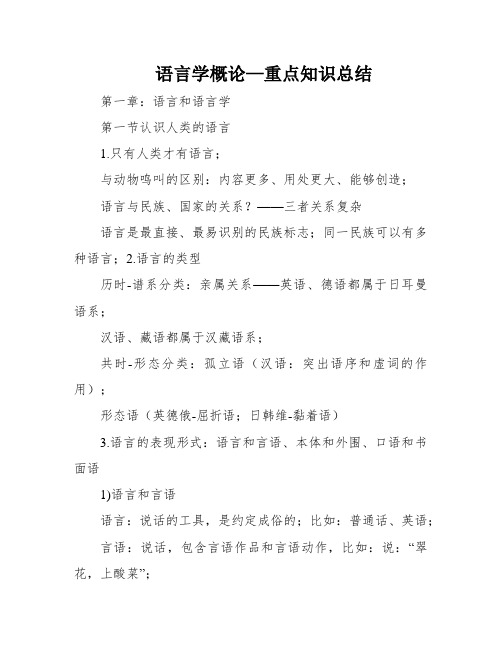
语言学概论—重点知识总结第一章:语言和语言学第一节认识人类的语言1.只有人类才有语言;与动物鸣叫的区别:内容更多、用处更大、能够创造;语言与民族、国家的关系?——三者关系复杂语言是最直接、最易识别的民族标志;同一民族可以有多种语言;2.语言的类型历时-谱系分类:亲属关系——英语、德语都属于日耳曼语系;汉语、藏语都属于汉藏语系;共时-形态分类:孤立语(汉语:突出语序和虚词的作用);形态语(英德俄-屈折语;日韩维-黏着语)3.语言的表现形式:语言和言语、本体和外围、口语和书面语1)语言和言语语言:说话的工具,是约定成俗的;比如:普通话、英语;言语:说话,包含言语作品和言语动作,比如:说:“翠花,上酸菜”;2)选择/名词:本体和外围本体:语言内部包含的要素,比如:语音、语法、语义;外围:语言和其他事物的关系,比如:语言和思维、语言和历史、语言和民族文化;3)口语和口语口语:说的话;第一性的,是书面语产生的基础书面语:写的字;第二性,在口语的基础上,加工提炼而成;第二节语言符号和语言结构1.语言符号必须同时具有表示具体意义的物质实体(红绿灯)和物质实体所表示的特定意义(红灯停绿灯行);2.语言的符号特性:能指和所指、约定和任意、不变和可变;1)能指和所指(口诀:能声所意)能指:把语言符号中能够指称某种意义的声音称为“能指”;所指:把语言符号中有特定声音表示的意义称为“所指”;2)约定和任意约定:人为的规定任意:符号表示意义没有必然联系,只需人人都认定或气就行3)不变和可变可变性的根本原因在于任意性3.语言的结构特性:线性和离散、组合和聚合、层次和层级1)线性和离散:构成语言结构的基础条件;线性:语言符号只能一个一个按工夫顺序成一条线排列;离散性:语言符合可以分解还原成一个一个的符号(词);2)组合和聚合组合:哪一个成分在前、哪一个成分在后的结构特征;(又叫句法功用)聚合:同一类成分可以相互替换的结构特性;3)层次和层级层次:一个小单位内部的成分组合叫做“层次”;(语素组合成词、词组合成词组、词组组合成句子)层级:各个小单位之间的联系叫做“层级”;(词和词一级的内在分别)第三节研究语言的科学1.学科研究的方向分类:本体研究、语言与心理、语言和使用;1)本体研究:对语音、语汇、语法、语义的研究;2)语言与心理研究:语言和心理之间的关系和相互影响;3)语言与应用研究:语言学和信息处理,把理论在实践中的运用;2.语言与哲学1)“名无固宜,约之以命,约定俗成谓之宜……”出自XXX的《正名篇》;2)“小学”包括:《文字学》、《音韵学》、《训诂学》;3.语言研究1)XXX的《通俗语言学教程》提出了“结构主义语言学”“能指和所指”,是结构语言学的奠基人;2)XXX:北美结构主义学家,间接成分分析法;3)乔姆斯基的“转换生成语法”,包括普遍语法、句法自治等观点;第二章语言的物质载体——语音第一节语音概说1.语音:“人说话的声音”,更严格地说,语音是人的发音器官发出的、用于人与人之间交际并表达一定意义的声音。
(完整版)胡壮麟语言学教程笔记、重点全解
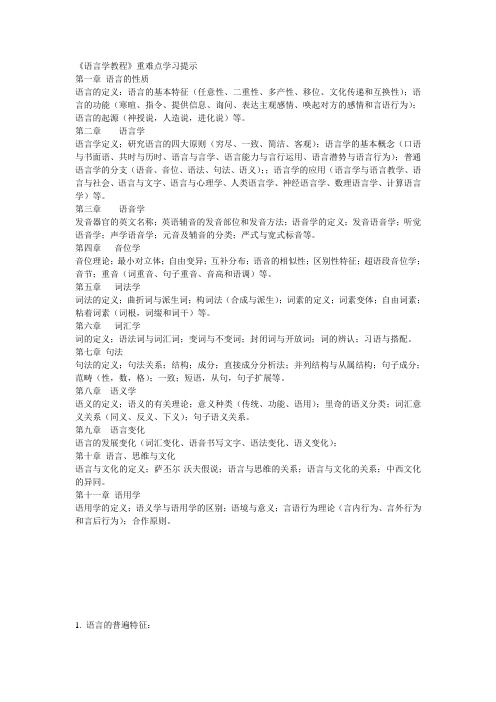
《语言学教程》重难点学习提示第一章语言的性质语言的定义:语言的基本特征(任意性、二重性、多产性、移位、文化传递和互换性);语言的功能(寒暄、指令、提供信息、询问、表达主观感情、唤起对方的感情和言语行为);语言的起源(神授说,人造说,进化说)等。
第二章语言学语言学定义;研究语言的四大原则(穷尽、一致、简洁、客观);语言学的基本概念(口语与书面语、共时与历时、语言与言学、语言能力与言行运用、语言潜势与语言行为);普通语言学的分支(语音、音位、语法、句法、语义);;语言学的应用(语言学与语言教学、语言与社会、语言与文字、语言与心理学、人类语言学、神经语言学、数理语言学、计算语言学)等。
第三章语音学发音器官的英文名称;英语辅音的发音部位和发音方法;语音学的定义;发音语音学;听觉语音学;声学语音学;元音及辅音的分类;严式与宽式标音等。
第四章音位学音位理论;最小对立体;自由变异;互补分布;语音的相似性;区别性特征;超语段音位学;音节;重音(词重音、句子重音、音高和语调)等。
第五章词法学词法的定义;曲折词与派生词;构词法(合成与派生);词素的定义;词素变体;自由词素;粘着词素(词根,词缀和词干)等。
第六章词汇学词的定义;语法词与词汇词;变词与不变词;封闭词与开放词;词的辨认;习语与搭配。
第七章句法句法的定义;句法关系;结构;成分;直接成分分析法;并列结构与从属结构;句子成分;范畴(性,数,格);一致;短语,从句,句子扩展等。
第八章语义学语义的定义;语义的有关理论;意义种类(传统、功能、语用);里奇的语义分类;词汇意义关系(同义、反义、下义);句子语义关系。
第九章语言变化语言的发展变化(词汇变化、语音书写文字、语法变化、语义变化);第十章语言、思维与文化语言与文化的定义;萨丕尔-沃夫假说;语言与思维的关系;语言与文化的关系;中西文化的异同。
第十一章语用学语用学的定义;语义学与语用学的区别;语境与意义;言语行为理论(言内行为、言外行为和言后行为);合作原则。
语言学教程[第十章语言和计算机]山东大学期末考试知识点复习
![语言学教程[第十章语言和计算机]山东大学期末考试知识点复习](https://img.taocdn.com/s3/m/ad5840f3aef8941ea76e056d.png)
第十章语言和计算机复习笔记I.计算机语言学简介1.计算机操作能力特指那些能使用计算机并具有大量计算机软件知识和技巧的人。
2.计算机语言学可以看作是应用语言学的分支,即通过计算机处理人类语言。
计算机语言学包括:对语言数据的分析,建立一个序列,通过它,语言学习者可以获得各种语法规律或某一特定词项的出现频率;人工言语的电子生成和人类语言的自动识别;它也包括不同自然语言之间的自动翻译和语篇处理;人与计算机的交流。
Ⅱ.计算机辅助语言学习1.CAI/CAI,vs.CALL(1)计算机辅助教学 (CAI),就是在教学过程中使用计算机。
(2)计算机辅助学习 (CAL),强调在教和学两方面使用计算机,通过学生自己的推理和实践,帮助学习者达到教学目标。
(3)计算机辅助语言学习(CALL):如果说CAI或CAL是处理一般的教和学,那么CALL则是用来处理语言教学的。
CALL特别是指将计算机运用到第二语言或外语的教学中去。
2.CALL的发展阶段(1)阶段1:在这个阶段,计算机限制在研究机构中运用,其主机非常大。
(2)阶段2:小型计算机出现了,比以前的要便宜。
这使得新一代程序的产生变为可能。
(3)阶段3:计算机被用作学生之间交流的激发点。
结果,对每个学生而言,计算机不再是个人资源,它逐渐被视为小组学习的焦点,这就使得许多被称为“交流性”的活动变得可行,例如,交互的多角色游戏。
(4)阶段4:文字处理不再是为语言教学编写具体的程序,而是适应语言教学,使学生用一种非永久性形式写作并能修改它们的作品。
3.技术(1)定制、模块和编程使用CALL进行教学的最大弹性在于编程的领域。
教师们能够就他们自己的材料,运用这些程序来创造简单的或精心制作的软件程序。
编程的范围是从简单模块程序到十分复杂的编程语言。
这使得多媒体有了发展的潜能,也使不太复杂的编程成为可能。
(2)计算机网络除了单独的程序以外,计算机通过网络连在一起,扩大了外语教学的途径。
英语考研 胡壮麟版 语言学教程英语考研 Chapter 11

Focus on Form
Although language learning should generally be meaning-focused and communicationoriented, it is still necessary and beneficial to focus on form occasionally.
解释,并逐字讲解。学生跟教师朗读单词。教师说出母语 意思,学生说了英语单词。 [3] 讲授语法:讲解语法意义及相关规则,在黑板上列出课 文中的相关词汇,学生按语法规则进行转换等。 [4] 讲解课文:教师逐句念课文,学生分析语法与译成母语。 教师随时纠正错误。 [5] 巩固新课:学生跟教师逐句朗读课文。教师依课文提问, 学生按课文回答。 [6] 布置作业:拼写单词;语法填空;背诵课文。
9
Focus on form: occasional attention on grammar with focusing on meaning at the same time. (聚焦于形式,形式与意义兼顾)
Focus on forms: traditional way of teaching grammar explicitly.(传统语法教学)
[4] 课堂用语大部分是母语。通过翻译检查教学质量。练
习方式有单句填空、造句、背诵课文和作文等。用母语组
织教学。把母语当作释义、讲解、练习和检查的重要手段,
很少积极使用目的语。
18
Grammar-translation method
[1] 通过母语的翻译和比较,能使学生比较深刻地理解外语 的抽象词义和复杂的句子结构。系统讲授语法知识,注意 利用学生的理解力,有利于启发思维,训练智慧,有助于 提高教学效果。学生语法概念清晰,词义理解较确切,翻 译能力得到培养。
(完整word版)语言学教程[第二章语音]山东大学期末考试知识点复习
![(完整word版)语言学教程[第二章语音]山东大学期末考试知识点复习](https://img.taocdn.com/s3/m/06bbfb6d71fe910ef02df8c6.png)
第二章语音复习笔记I.语音学和音系学的定义1.语音学语音学研究语音的发生、传递和感知。
2.语音学研究的三大领域(1)发音语言学研究语音的发生。
(2)声学语音学研究语音的物质特征。
(3)感知语音学(或听觉语音学)研究语音的感知。
3.音系学音系学研究的是语言的语音系统。
换句话说,音系学研究的是说话人为表达意义而系统地选择语音的方法。
Ⅱ.发音器官1.发音器官是人体参与语音发生的那部分,包括肺、气管、喉、鼻和口。
2.清音在发音过程中,发音时声带不振动,这样所发出的音叫做清音。
3.浊音在发音过程中,发音时声带振动,这样所发出的音叫做浊音。
4.国际音标(1)国际音标是一个标准的、被国际上广泛接受的语音描述系统。
(2)它的基本原则是用不同的字母符号来表示不同的发音.(3)经过几次修正,目前国际音标仍然被语音学家和语言学家广泛使用.Ⅲ.辅音和元音1.定义(1)发音时,声道的某些部位受到压缩或阻碍后,使得气流在口腔里转向、受阻或完全被阻塞,由此产生的音叫做辅音。
(2)发音时,声道不受任何压缩或阻碍,因此不会有气流的紊乱或停滞,由此产生的音叫做元音。
2.辅音(1)发音方式和发音部位①发音方式指发音器官之间的关系,以及气流经过声道的某些部位时的方式。
②发音部位指声道的哪些部位发生气流摩擦、狭窄化或阻碍.(2)辅音的分类①按发音方式分类,辅音可分为爆破音、鼻音、擦音、近音、边音、颤音、触音和闪音以及塞擦音。
爆破音:[p,b,t,d,k,g]鼻音:[m,n,n]擦音:[f,v,o,6,s,z,J,3,h]近音:[w,J,j]边音:[l]颤音:[ts,dz,tr,dr]②按发音部位分类,辅音可分为双唇音、唇齿音、齿音、齿龈音、齿龈后音、卷舌音、硬腭音、软腭音、小舌音、咽音和声门音。
双唇音:[p,b,m]唇齿音:[f,v]齿音:[0,6]齿龈音:[t,d,n,s,z,j,l]齿音后音:[f,3]硬腭音:[j]软腭音:[k,g,n]声门音:[h]3.元音(1)基本元音基本元音是指一系列约定俗成的、固定不变的元音特质,目的是为语言中实际存在的元音描述提供一个参照框架。
(完整word版)胡壮麟语言学教程笔记、重点
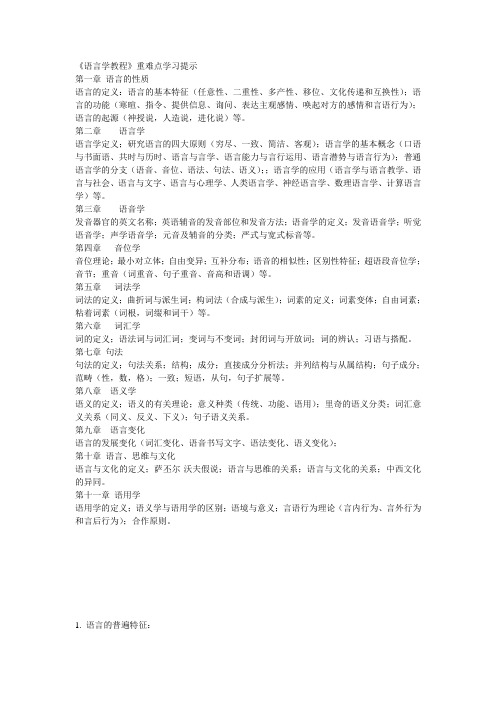
《语言学教程》重难点学习提示第一章语言的性质语言的定义:语言的基本特征(任意性、二重性、多产性、移位、文化传递和互换性);语言的功能(寒暄、指令、提供信息、询问、表达主观感情、唤起对方的感情和言语行为);语言的起源(神授说,人造说,进化说)等。
第二章语言学语言学定义;研究语言的四大原则(穷尽、一致、简洁、客观);语言学的基本概念(口语与书面语、共时与历时、语言与言学、语言能力与言行运用、语言潜势与语言行为);普通语言学的分支(语音、音位、语法、句法、语义);;语言学的应用(语言学与语言教学、语言与社会、语言与文字、语言与心理学、人类语言学、神经语言学、数理语言学、计算语言学)等。
第三章语音学发音器官的英文名称;英语辅音的发音部位和发音方法;语音学的定义;发音语音学;听觉语音学;声学语音学;元音及辅音的分类;严式与宽式标音等。
第四章音位学音位理论;最小对立体;自由变异;互补分布;语音的相似性;区别性特征;超语段音位学;音节;重音(词重音、句子重音、音高和语调)等。
第五章词法学词法的定义;曲折词与派生词;构词法(合成与派生);词素的定义;词素变体;自由词素;粘着词素(词根,词缀和词干)等。
第六章词汇学词的定义;语法词与词汇词;变词与不变词;封闭词与开放词;词的辨认;习语与搭配。
第七章句法句法的定义;句法关系;结构;成分;直接成分分析法;并列结构与从属结构;句子成分;范畴(性,数,格);一致;短语,从句,句子扩展等。
第八章语义学语义的定义;语义的有关理论;意义种类(传统、功能、语用);里奇的语义分类;词汇意义关系(同义、反义、下义);句子语义关系。
第九章语言变化语言的发展变化(词汇变化、语音书写文字、语法变化、语义变化);第十章语言、思维与文化语言与文化的定义;萨丕尔-沃夫假说;语言与思维的关系;语言与文化的关系;中西文化的异同。
第十一章语用学语用学的定义;语义学与语用学的区别;语境与意义;言语行为理论(言内行为、言外行为和言后行为);合作原则。
英语语言学第十一章笔记
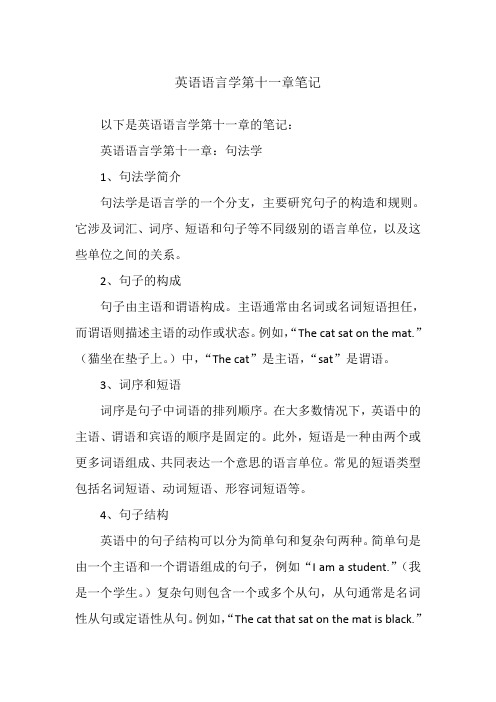
英语语言学第十一章笔记以下是英语语言学第十一章的笔记:英语语言学第十一章:句法学1、句法学简介句法学是语言学的一个分支,主要研究句子的构造和规则。
它涉及词汇、词序、短语和句子等不同级别的语言单位,以及这些单位之间的关系。
2、句子的构成句子由主语和谓语构成。
主语通常由名词或名词短语担任,而谓语则描述主语的动作或状态。
例如,“The cat sat on the mat.”(猫坐在垫子上。
)中,“The cat”是主语,“sat”是谓语。
3、词序和短语词序是句子中词语的排列顺序。
在大多数情况下,英语中的主语、谓语和宾语的顺序是固定的。
此外,短语是一种由两个或更多词语组成、共同表达一个意思的语言单位。
常见的短语类型包括名词短语、动词短语、形容词短语等。
4、句子结构英语中的句子结构可以分为简单句和复杂句两种。
简单句是由一个主语和一个谓语组成的句子,例如“I am a student.”(我是一个学生。
)复杂句则包含一个或多个从句,从句通常是名词性从句或定语性从句。
例如,“The cat that sat on the mat is black.”(坐在垫子上的猫是黑色的。
)是一个包含定语性从句的复杂句。
5、转换语法转换语法是句法学的一个重要分支,研究如何通过改变词语的属性或结构来改变句子的意义。
例如,“I like eating pizza”和“Pizza is delicious”是两个意义不同的句子,但它们可以通过转换语法相互转化。
6、语言习得和句法学句法学在语言习得中扮演着重要的角色。
研究发现,儿童在习得语言时通常会先学会基本的词汇和短语,然后逐渐学习更复杂的句子结构和语法规则。
句法学的研究有助于我们更好地理解儿童语言习得的过程,也为二语习得提供了重要的理论依据。
《语言学教程》中文笔记(完整)
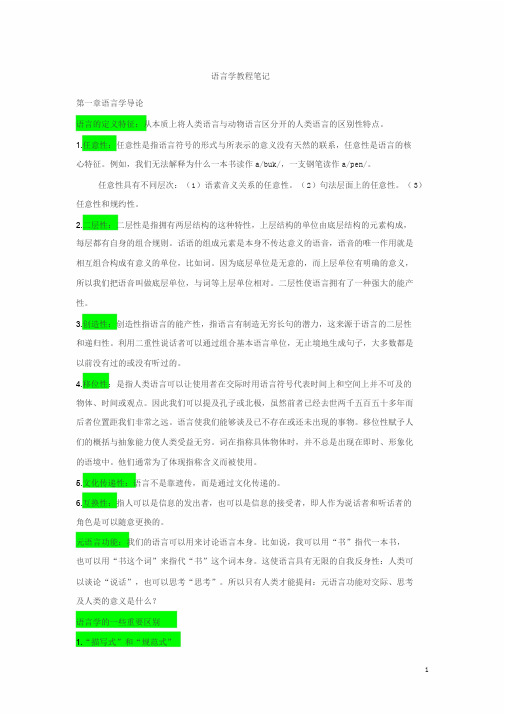
语言学教程笔记第一章语言学导论语言的定义特征:从本质上将人类语言与动物语言区分开的人类语言的区别性特点。
1.任意性:任意性是指语言符号的形式与所表示的意义没有天然的联系,任意性是语言的核心特征。
例如,我们无法解释为什么一本书读作a/buk/,一支钢笔读作a/pen/。
任意性具有不同层次:(1)语素音义关系的任意性。
(2)句法层面上的任意性。
(3)任意性和规约性。
2.二层性:二层性是指拥有两层结构的这种特性,上层结构的单位由底层结构的元素构成,每层都有自身的组合规则。
话语的组成元素是本身不传达意义的语音,语音的唯一作用就是相互组合构成有意义的单位,比如词。
因为底层单位是无意的,而上层单位有明确的意义,所以我们把语音叫做底层单位,与词等上层单位相对。
二层性使语言拥有了一种强大的能产性。
3.创造性:创造性指语言的能产性,指语言有制造无穷长句的潜力,这来源于语言的二层性和递归性。
利用二重性说话者可以通过组合基本语言单位,无止境地生成句子,大多数都是以前没有过的或没有听过的。
4.移位性:是指人类语言可以让使用者在交际时用语言符号代表时间上和空间上并不可及的物体、时间或观点。
因此我们可以提及孔子或北极,虽然前者已经去世两千五百五十多年而后者位置距我们非常之远。
语言使我们能够谈及已不存在或还未出现的事物。
移位性赋予人们的概括与抽象能力使人类受益无穷。
词在指称具体物体时,并不总是出现在即时、形象化的语境中。
他们通常为了体现指称含义而被使用。
5.文化传递性:语言不是靠遗传,而是通过文化传递的。
6.互换性:指人可以是信息的发出者,也可以是信息的接受者,即人作为说话者和听话者的角色是可以随意更换的。
元语言功能:我们的语言可以用来讨论语言本身。
比如说,我可以用“书”指代一本书,也可以用“书这个词”来指代“书”这个词本身。
这使语言具有无限的自我反身性:人类可以谈论“说话”,也可以思考“思考”。
所以只有人类才能提问:元语言功能对交际、思考及人类的意义是什么?语言学的一些重要区别1.“描写式”和“规范式”描写式:客观系统地记录一种语言的模式和用法或变化。
语言学课后练习

语言学教程(修订版) 练习参考答案修订版第一章语言学导论 1第二章语音 3第三章词汇 8第四章句法 11第五章语义 15第六章语言与思维 18第七章语言、文化与社会 20第八章语用 21第九章语言与文学 24第十章语言与计算机 25第十一章语言学与外语教学 28第十二章现代语言学的学派与理论 30第一章语言学导论1. Define the following terms:1) design features: are features that define our human languages, such as arbitrariness, duality, creativity, displacement, cultural transmission, etc.2) function: the role language plays in communication (e.g. to express ideas, attitudes) or in particular social situations (e.g. religious, legal).Language functions include informative function (also ideational function), interpersonal function, performative function, emotive function, phatic communion, recreational function and metalingual function.3) etic: a term in contrast with emic which originates from American linguist Pike’s distinction of phonetics and phonemics. Being etic means making far too many, as well as behaviorsly inconsequential, differentiations, just as was often the case with phonetic vs. phonemic analysis in linguistics proper.4) emic: a term in contrast with etic which originates from American linguist Pike’s distinction of phonetics and phonemics. An emic set of speech acts and events must be one that is validated as meaningful via final resource to the native members of a speech community rather than via appeal to the investigator’s ingenuity or intuition alone.5) synchronic: a kind of description which takes a fixedinstant(usually, but not necessarily, the present), as its point of observation. Most grammars are of this kind.6) diachronic: study of a language is carried through the course of its history.7) prescriptive: a kind of linguistic study in which things are prescribed how ought to be, i.e. laying down rules for language use.8) descriptive: a kind of linguistic study in which things are just described.9) arbitrariness: one design feature of human language, whichrefers to the fact that the forms of linguistic signs bear no natural relationship to their meaning.(1) Arbitrary relationship between the sound of a morpheme and its meaning(2) At the syntactic level(3) Arbitrariness and convention (convention: the link between a linguistic sign and its meaning)10) duality: one design feature of human language, which refers to the property of having two levels of structures, such that units of the primary level are composed of elements of the secondary level and each of the two levels has its own principles of organization.11) displacement: one design feature of human language, which means that human languages enable their users to symbolize objects, events and concepts which are not present (in time and space) at the moment of communication.12) phatic communion: one function of human language, which refersto the social interaction of language.13) metalanguage: a language used for talking about language.14) macrolinguistics: The interacting study between language and language-related disciplines such as psychology, sociology, ethnography, science of law and artificial intelligence etc. Branches of macrolinguistics include psycholinguistics, sociolinguistics, anthropological linguistics, etc.15) competence: a language user’s underlying knowledge about the system of rules.16) performance: the actual use of language in concretesituations.(Chomsky, 1965:3)17) langue: the linguistic competence of the speaker.18) parole: the actual phenomena or data of linguistics(utterances).2. Consult at least four introductory linguistics textbooks (not dictionaries), and copy the definitions of language that each gives.After carefully comparing the definitions, write a paper discussingwhich points recur and explaining the significance of the similarities and differences among the definitions.All the definitions should not exclude the description of design features that have been mentioned in this course book. Also it will be better if other design features, say, interchangeability or cultural transmission is included. But it seems impossible to give an unimpeachable definition on language, because the facets people want to emphasize are seldom unanimous. To compare several definitions can make you realize where the argument is.3. Can you think of some words in English which are onomatopoeic?creak: the sound made by a badly oiled door when it opens.cuckoo: the call of cuckoo.bang: a sudden loud noise.roar: a deep loud continuing sound.buzz: a noise of buzzing.hiss: a hissing sound.neigh: the long and loud cry that a horse makes.mew: the noise that a gull makes.bleat: the sound made by a sheep, goat or calf.4. Do you think that onomatopoeia indicates a non-arbitrary relationship between form and meaning?Not really. Onomatopoeia is at most suggestive of the natural sounds they try to capture. They are arbitrary as signifiers.Before we feel a word is onomatopoeic we should first know which sound the word imitates. For example, in order to imitate the noise of flying mosquitoes, there are many choices like "murmurous" and "murderous". They both bear more or less resemblance to the genuine natural sound, but "murmurous" is fortunately chosen to mean the noise while "murderous" is chosen to mean something quite different. They are arbitrary as signifiers.5. A story by Robert Louis Stevenson contains the sentence “As the night fell, the wind rose.” Could this be expressed as “As the wind rose, the night fell?” If not, why? Does this indicate a degree of non-arbitrariness about word order? (Bolinger, 1981: 15)Yes. Changing the order of the two clauses may change the meaningof the sentence, because clauses occurring in linear sequence without time indicators such as “before” or “after” will be taken as matching the actual sequence of happening.6. Does the traffic light system have duality? Why?No. No discrete units on the first level that can be combinedfreely in the second level to form meaning. There is only simple one-to-one relationship between signs and meaning, namely, red—stop, green—go and yellow—get ready to go or stop.7. Communication can take many forms, such as sign, speech, body language and facial expression. Do body language and facial expression share or lack the distinctive properties of human language?On a whole, body language and facial expression lack most of the distinctive properties of human language such as duality, displacement, creativity and so on. Body language exhibits arbitrariness a little bit. For instance, nod means "OK/YES" for us but in Arabian world it is equal to saying "NO". Some facial expressions have non-arbitrariness because they are instinctive such as the cry and laugh of a newborn infant.8. Do you agree with the view that no language is especially simple?Yes. All human languages are complicated systems of communication.It is decided by their shared design features.9. Can you mention some typical expressions of phatic communion in Chinese?Some of the typical phatic expressions in Chinese are: 吃了吗?家里都好吧?这是去哪里啊?最近都挺好的?10. Comment on the following prescriptive rules. Do you think they are acceptable?(A) It is I. (B) It is me.You should say A instead of B because “be” should be followed by the nominative case, not the accusative according to the rules in Latin.(A) Who did you speak to? (B) Whom did you speak to?You should say B instead of A.(A) I haven't done anything. (B) I haven't done nothing.B is wrong because two negatives make a positive.(1) the Latin rule is not universal. In English, me is informal andI is felt to be very formal.(2) Whom is used in formal speech and in writing; who is more acceptable in informal speech.(3) Language does not have to follow logic reasoning. Here two negative only make a more emphatic negative. This sentence is not acceptable in Standard English not because it is illogical, but because language changes and rejects this usage now.11. Why is competence and performance an important distinction in linguistics? Do you think the line can be neatly drawn between them? How do you like the concept “communicative competence”?This is proposed by Chomsky in his formalist linguistic theories.It is sometimes hard to draw a strict line. Some researchers in applied linguistics think communicative competence may be a more revealing concept in language teaching than the purely theoretical pair—competence and performance.12. Which branch of linguistics do you think will develop rapidlyin China and why? (up to you)13. There are many reasons for the discrepancy between competence and performance in normal language users. Can you think of some of them?Ethnic background, socioeconomic status, region of the country, and physical state changes within the individual, such as intoxication, fatigue, distraction, illness.14. What do these two quotes reveal about the different emphasis or perspectives of language studies?(1) A human language is a system of remarkable complexity. To come to know a human language would be an extraordinary intellectual achievement for a creature not specifically designed to accomplish this task. A normal child acquires this knowledge on relatively slight exposure and without specific training. He can then quite effortlessly make use of an intricate structure of specific rules and guiding principles to convey his thoughts and feelings to others, ... Thus language is a mirror of mind in a deep and significant sense. It is a product of human intelligence, created anew in each individual by operations that lie far beyond the reach of will or consciousness.(Noam Chomsky: Reflections on Language. 1975: 4)(2) It is fairly obvious that language is used to serve a varietyof different needs, but until we examine its grammar there is no clear reason for classifying its uses in any particular way. However, when we examine the meaning potential of language itself, we find that the vast numbers of options embodied in it combine into a very few relatively independent “networks”; and these networks of options correspond to certain basic functions of language. This enables us to give an accountof the different functions of language that is relevant to the general understanding of linguistic structure rather than to any particular psychological or sociological investigation.(M. A. K. Halliday, 1970: 142)The first quote shows children’s inborn ability of acquir ing the knowledge of intricate structure of specific rules. It implies that the language user's underlying knowledge about the system of rules is the valuable object of study for linguists. The second attaches great importance to the functions of language. It regards the use of language as the choice of needed function. The meaning of language can be completely included by a few “networks” which is directly related to basic functions of language. It indicates the necessity to study the functions of language.附:1. The recursive nature of language provides a theoretical basis for the creativity of language. Can you write a recursive sentence following the example in section 1.3.3.Today I encountered an old friend who was my classmate when I was in elementary school where there was an apple orchard in which we slid to select ripe apples that…2. What do you think of Bertrand Russell’s observation of the dog language: “No matter how eloquently a dog may bark, he cannot tell you that his parents were poor bu t honest”? Are you familiar with any type of ways animals communicate among themselves and with human beings?When gazelles sense potential danger, for example, they flee and thereby signal to other gazelles in the vicinity that danger is lurking.A dog signals its wish to be let inside the house by barking and signals the possibility that it might bite momentarily by displaying its fangs.3. There are many expressions in language which are metalingual or self-reflexives, namely, talking about talk and think about thinking,for instance, to be honest, to make a long story short, come to think of it, on second thought, can you collect a few more to make a list of these expressions? When do we use them most often?To tell the truth, frankly speaking, as a matter of fact, to be precise, in other words, that is to saySuch expressions are used most frequently when we want to expatiate the meaning of former clauses in anther way in argumentation.第二章语音1. Define the following terms:1) articulatory phonetics: the study of the production of speech sounds.2) coarticulation: a kind of phonetic process in which simultaneous or overlapping articulations are involved.If the sound becomes more like the following sound, as in the case of lamb, it is know as anticipatory coarticulation.If the sound displays the influence of the preceding sound, it is perseverative coarticulation, as is the case of map.3) Voicing: the vibration of the vocal folds.When the vocal folds are close together, the airstream causes them to vibrate against each other and the resultant sound is said to be “voiced”. When the vocal folds are apart and the air can pass through easily, the sound produced is said to be “voiceless”. When they are totally closed, no air can pass between them. The result of this gesture is the glottal stop [?]4) Broad and narrow transcription: the use of a simple set of symbols in transcription is called broad transcription; the use of more specific symbols to show more phonetic detail is referred to as narrow transcription.5) consonant: consonants are sound segments produced byconstricting or obstructing the vocal tract at some place to divert, impede, or completely shut off the flow of air in the oral cavity.6) phoneme: a unit of explicit sound contrast. If two sounds in a language make a contrast between two different words, they are said to be different phonemes.7) vowel: vowels are sound segments produced without obstruction of the vocal tract, so no turbulence or a total stopping of the air can be perceived.8) allophone: variants of the same phoneme. If two or more phonetically different sounds do not make a contrast in meaning, they are said to be allophones of the same phoneme. To be allophones, they must be in complementary distribution and bear phonetic similarity.9) manner of articulation: in the production of consonants, manner of articulation refers to the actual relationship between the articulators and thus the way in which the air passes through certain parts of the vocal tract.10) place of articulation: the point where an obstruction to the flow of air is made in producing a consonant.11) distinctive features: a term of phonology, i.e. a property which distinguishes one phoneme from another. (suggested by Roman Jacobson in the 1940s)12) complementary distribution: the relation between two speech sounds that never occur in the same environment. Allophones of the same phoneme are usually in complementary distribution.13) IPA: the abbreviation of International Phonetic Alphabet, which is devised by the International Phonetic Association in 1888 then it has been revised from time to time to include new discoveries and changes in phonetic theory and practice. The latest version has been revised in 1993 and updated in 2005.14) suprasegmental: suprasegmental features are those aspects of speech that involve more than single sound segments. The principal suprasegmental features are syllable, stress, tone, and intonation.2. Answer the following questions.1) What organs are involved in speech production?Quite a few human organs are involved in the production of speech: the lungs, the trachea (or windpipe), the throat, the nose, and the mouth.The pharynx, mouth, and nose form the three cavities of the vocal tract. Speech sounds are produced with an airstream as their sources of energy. In most circumstances, the airstream comes from the lungs. It is forced out of the lungs and then passes through the bronchioles and bronchi, a series of branching tubes, into the trachea. Then the air is modified at various points in various ways in the larynx, and in theoral and nasal cavities: the mouth and the nose are often referred to, respectively, as the oral cavity and the nasal cavity.Inside the oral cavity, we need to distinguish the tongue and various parts of the palate, while inside the throat, we have to distinguish the upper part, called pharynx, from the lower part, known as larynx. The larynx opens into a muscular tube, the pharynx, part of which can be seen in a mirror. The upper part of the pharynx connects to the oral and nasal cavities.The contents of the mouth are very important for speech production. Starting from the front, the upper part of the mouth includes the upper lip, the upper teeth, the alveolar ridge, the hard palate, the soft palate (or the velum), and the uvula. The soft palate can be lowered toallow air to pass through the nasal cavity. When the oral cavity is at the same time blocked, a nasal sound is produced.The bottom part of the mouth contains the lower lip, the lower teeth, the tongue, and the mandible.At the top of the trachea is the larynx, the front of which is protruding in males and known as the “Adam’s Apple”. The larynx contains the vocal folds, also known as “vocal cords” or “vocal bands”, a nd the ventricular folds. The vocal folds are a pair of structure that lies horizontally below the latter and their front ends are joined together at the back of the Adam’s Apple. Their rear ends, however, remain separated and can move into various positions: inwards, outwards, forwards, backwards, upwards and downwards.2) How is the description of consonants different from that of vowels?In the production of consonants at least two articulators are involved. For example, the initial sound in bad involves both lips andits final segment involves the blade (or the tip) of the tongue and the alveolar ridge. The categories of consonant, therefore, are established on the basis of several factors. The most important of these factors are: (a) the actual relationship between the articulators and thus the way in which the air passes through certain parts of the vocal tract, and (b) where in the vocal tract there is approximation, narrowing, or the obstruction of air. The former is known as the Manner of Articulationand the latter as the Place of Articulation.The Manner of Articulation refers to ways in which articulation can be accomplished: (a) the articulators may close off the oral tract foran instant or a relatively long period; (b) they may narrow the space considerably; or (c) they may simply modify the shape of the tract by approaching each other.The Place of Articulation refers to the point where a consonant is made. Practically consonants may be produced at any place between thelips and the vocal folds. Eleven places of articulation aredistinguished on the IPA chart.As the vowels cannot be described in the same way as the consonants, a system of cardinal vowels has been suggested to get out of this problem. The cardinal vowels, as exhibited by the vowel diagram in the IPA chart, are a set of vowel qualities arbitrarily defined, fixed and unchanging, intended to provide a frame of reference for the description of the actual vowels of existing languages.The cardinal vowels are abstract concepts. If we imagine that for the production of [@] the tongue is in a neutral position (neither high nor low, neither front nor back), the cardinal vowels are as remote as possible from this neutral position. They represent extreme points of a theoretical vowel space: extending the articulators beyond this space would involve friction or contact. The cardinal vowel diagram (or quadrilateral) in the IPA is therefore a set of hypothetical positionsfor vowels used as reference points.The front, center, and back of the tongue are distinguished, as are four levels of tongue height: the highest position the tongue canachieve without producing audible friction (high or close); the lowestposition the tongue can achieve (low or open); and two intermediate levels, dividing the intervening space into auditorily equivalent areas (mid-high or close -mid, and mid-low or open-mid).3) To what extent is phonology related to phonetics and how do they differ?Both phonetics and phonology study human speech sounds but they differ in the levels of analysis. Phonetics studies how speech sounds are produced, transmitted, and perceived. Imagine that the speech sound is articulated by a Speaker A. It is then transmitted to and perceived by a Listener B. Consequently, a speech sound goes through a three-step process: speech production, sound transmission, and speech perception.Naturally, the study of sounds is divided into three main areas, each dealing with one part of the process: Articulatory Phonetics is the study of the production of speech sounds, Acoustic Phonetics is the study of the physical properties of speech sounds, and Perceptual or Auditory Phonetics is concerned with the perception of speech sounds.Phonology is the study of the sound patterns and sound systems of languages. It aims to discover the principles that govern the way sounds are organized in languages, and to explain the variations that occur.In phonology we normally begin by analyzing an individual language, say English, in order to determine its phonological structure, i.e. which sound units are used and how they are put together. Then we compare the properties of sound systems in different languages in order to make hypotheses about the rules that underlie the use of sounds inthem, and ultimately we aim to discover the rules that underlie the sound patterns of all languages.4) What is assimilation?The change of a sound as a result of the influence of an adjacent sound, which is more specifically called “contact” or “contiguous” assimilation.3. Give the description of the following sound segments in English.1) [e]2) [?]3) [?]4) [d]5) [p]6) [k]7) [l]8) [?]9) [u?]10) [?]1) voiced dental fricative2) voiceless postalveolar fricative3) velar nasal4) voiced alveolar stop/plosive5) voiceless bilabial stop/plosive6) voiceless velar stop/plosive7) (alveolar) lateral8) high front unrounded lax vowel9) high back rounded tense vowel10) low back rounded lax vowel注:lax:短音,tense: 长音4. In some dialects of English the following words have different vowels, as shown by the phonetic transcription. Based on these data, answer the questions that follow.A B Cbite [b??t] bide [ba?d] tie [ta?]rice [r??s] rise [ra?z] by [ba?]type [t??p] bribe [bra?b] sigh [sa?]wife [w??f] wives [wa?vz] die [da?]tyke [t??k] time [ta?m] why [wa?]nine [na?n]tile [ta?l]tire [ta?r]writhe [ra?e]1) How may the classes of sounds that end the words in columns A and B be characterized?All the sounds that end the words in column A are voiceless ([ - voiced ]) and all the sounds that end the words in column B arevoiced([ + voiced ]).2) How do the words in column C differ from those in columns A and B?The words in column C are all open syllables, i.e. they end in vowels.3) Are [??] and [a?] in complementary distribution? Give your reasons.The two sounds are in complementary distribution because [??]appear before voiceless consonants and [a?] occurs before voiced consonants and in open syllables.4) What are the phonetic transcriptions of (a) life and (b) lives?Life [l??f] lives[la?vz]5) What would the phonetic transcriptions of the following words be?(a) trial (b) bike (c) lice (d) fly (e) mine(a) [tra?l] (b) [b??k] (c) [l??s] (d) [fla?] (e) [ma?n]6) State the rule that will relate the phonemic representations to the phonetic transcriptions of the words given above./a?/ →[??] / _____[–voice][a?] in other places5. What is the rule that underlies the past tense forms of the regular verbs in English? Collect some data and state the rule.d→ id/t /[ - voiced ]d elsewherecons: continual. 附:Low(1) /p/→[p]/[s]__________/p/在[s]后发音为[p][p] elsewhere/p/在其它地方发音为[p](2) /l/→[l]/__________V/l/在元音前发音为[l] (alveolar)[?]/V__________/l/在元音后发音为[?] (lateral)(3) f, v; , ; s, z;Fricatives and affricatives in English may be assimilated in voicing.(4) /v/→[f]voiced fricative →voiceless/__________voiceless在清音间前摩擦音变为清音(5) Nasalization rule[ - nasal] →[ + nasal]/__________ [ + nasal](6) Dentalization rule[ - dental] →[ + dental]/__________ [ + dental](7) Velarization rule[ - velar] →[ + velar]/__________[ + velar](8) → [n]/[]__________Va在元音前发音为[n] (an)(9) a. The /s/ appears after voiceless sounds.b. The /z/ appears after voiced sounds. (All vowels are voiced.)c. The /z/ appears after sibilants.(10) z → s /[ - voice, C]__________ (Devoicing浊音变清音)(11) → /sibilant__________ z (Epenthesis插音)(12) a. // + // b.// + // c.// + //N/A N/A Epenthesiss N/A N/A Devoicingbdz kesz Output(13)a. [ - voiced, - cont] → [ - spread]/s______b. [ + spread]spread: aspirated.(14) Syllabic structure of clasp(15) Sonority scale:Most sonorous醒目的 5 Vowels4 Approximants3 Nasals2 FricativesLost sonorous 1 Stops(16) clasp(18) *lkaps。
语言学概论[第一章导论]山东大学期末考试知识点复习
![语言学概论[第一章导论]山东大学期末考试知识点复习](https://img.taocdn.com/s3/m/62b7516969eae009581becef.png)
第一章导论1.语言学语言学是以语言作为研究对象的科学。
语言学的基本任务是研究语言的内部存在、发展、演变运行的规律。
具体而言,通过考察语言及其应用的现象,研究语言的性质、结构、功能、发展演变以及与社会的相互联系,来揭示语言存在、发展与变化的规律,从而提高学习语言和运用语言的水平。
2.语言学的三大发源地分别是中国、印度、希腊—罗马。
3.中国的语文学中国的语文学被我们称之为“小学”,包括文字学、音韵学、训诂学三部分。
文字学分析字形,音韵学研究字音,训诂学解释字义(词义)。
4.语言信息传递语言传递信息过程实际上就是言语的交际过程,从信息传输的角度来看,它共有编码、发出、传递、接收、译码(解码)五个阶段。
5.一般了解语言学在科学体系中的地位,了解语言学的作用。
6.语言学的基本类别专语语言学:以一种具体语言为研究对象的语言学是专语语言学。
专语语言学只研究某一种语言。
比如汉语语言学、英语语言学、俄语语言学、法语语言学等。
普通语言学:以人类一般语言为研究对象,研究人类语言的性质、结构、功能、演变发展规律,在广泛的专语语言研究成果的基础上建立起来的一门学科,是语言学领域的理论基础。
应用语言学:研究语言在各个领域中实际应用的学科,是一门交叉性学科。
它有狭义和广义两种,狭义的应用语言学是指语言教学中的理论和方法研究,广义应用语言学范围广泛,有语言教学、词典编纂、机器翻译、人工智能、情报检索、信息处理等,还有人把社会语言学、神经语言学、计算语言学、数理语言学、心理语言学等都归为广义的应用语言学。
7.语言学流派语言学流派掌握最基本的知识,例如掌握历史比较语言学、结构主义语言学(比如布拉格学派、哥本哈根学派、美国学派)、形式语言学(比如转换生成语法)的基本情况,主要流派的代表人物及其主要观点与贡献等。
胡壮麟《语言学教程》笔记第10-11章
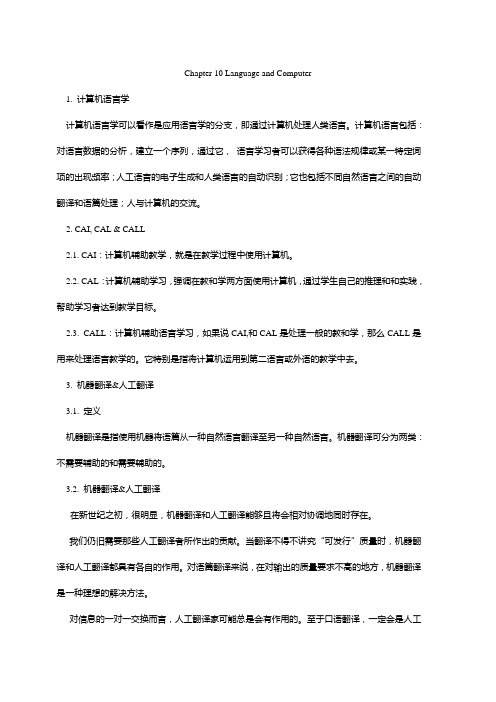
Chapter 10 Language and Computer1. 计算机语言学计算机语言学可以看作是应用语言学的分支,即通过计算机处理人类语言。
计算机语言包括:对语言数据的分析,建立一个序列,通过它,语言学习者可以获得各种语法规律或某一特定词项的出现频率;人工语言的电子生成和人类语言的自动识别;它也包括不同自然语言之间的自动翻译和语篇处理;人与计算机的交流。
2. CAI, CAL & CALL2.1. CAI:计算机辅助教学,就是在教学过程中使用计算机。
2.2. CAL:计算机辅助学习,强调在教和学两方面使用计算机,通过学生自己的推理和和实践,帮助学习者达到教学目标。
2.3. CALL:计算机辅助语言学习,如果说CAI,和CAL是处理一般的教和学,那么CALL是用来处理语言教学的。
它特别是指将计算机运用到第二语言或外语的教学中去。
3. 机器翻译&人工翻译3.1. 定义机器翻译是指使用机器将语篇从一种自然语言翻译至另一种自然语言。
机器翻译可分为两类:不需要辅助的和需要辅助的。
3.2. 机器翻译&人工翻译在新世纪之初,很明显,机器翻译和人工翻译能够且将会相对协调地同时存在。
我们仍旧需要那些人工翻译者所作出的贡献。
当翻译不得不讲究“可发行”质量时,机器翻译和人工翻译都具有各自的作用。
对语篇翻译来说,在对输出的质量要求不高的地方,机器翻译是一种理想的解决方法。
对信息的一对一交换而言,人工翻译家可能总是会有作用的。
至于口语翻译,一定会是人工翻译者的市场。
4. 计算机语料库4.1. 语料库(corpus)A collection of linguistic data, either compiled as written texts or as a transcription of recorded speech. The main purpose of a corpus is to verify a hypothesis about language--- for example, to determine how the application of a particular sound, word, or syntactic construction varies.语料库是一个语言数据的集合,可以有书面文本构成,也可以由录音言语的转写本构成。
语言学笔记重点
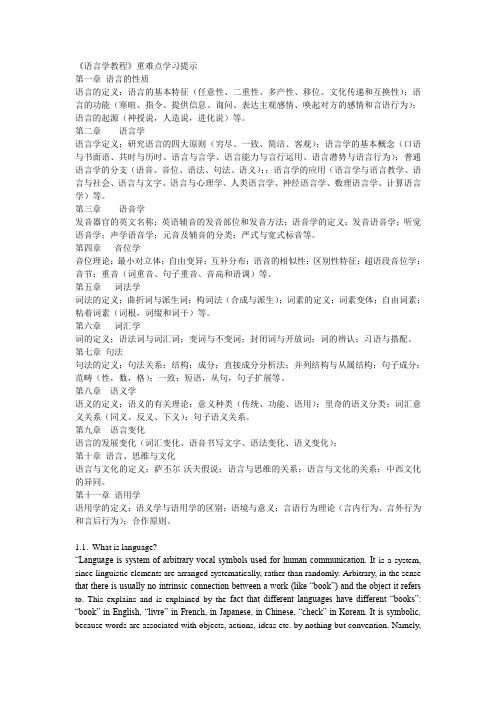
《语言学教程》重难点学习提示第一章语言的性质语言的定义:语言的基本特征(任意性、二重性、多产性、移位、文化传递和互换性);语言的功能(寒暄、指令、提供信息、询问、表达主观感情、唤起对方的感情和言语行为);语言的起源(神授说,人造说,进化说)等。
第二章语言学语言学定义;研究语言的四大原则(穷尽、一致、简洁、客观);语言学的基本概念(口语与书面语、共时与历时、语言与言学、语言能力与言行运用、语言潜势与语言行为);普通语言学的分支(语音、音位、语法、句法、语义);;语言学的应用(语言学与语言教学、语言与社会、语言与文字、语言与心理学、人类语言学、神经语言学、数理语言学、计算语言学)等。
第三章语音学发音器官的英文名称;英语辅音的发音部位和发音方法;语音学的定义;发音语音学;听觉语音学;声学语音学;元音及辅音的分类;严式与宽式标音等。
第四章音位学音位理论;最小对立体;自由变异;互补分布;语音的相似性;区别性特征;超语段音位学;音节;重音(词重音、句子重音、音高和语调)等。
第五章词法学词法的定义;曲折词与派生词;构词法(合成与派生);词素的定义;词素变体;自由词素;粘着词素(词根,词缀和词干)等。
第六章词汇学词的定义;语法词与词汇词;变词与不变词;封闭词与开放词;词的辨认;习语与搭配。
第七章句法句法的定义;句法关系;结构;成分;直接成分分析法;并列结构与从属结构;句子成分;范畴(性,数,格);一致;短语,从句,句子扩展等。
第八章语义学语义的定义;语义的有关理论;意义种类(传统、功能、语用);里奇的语义分类;词汇意义关系(同义、反义、下义);句子语义关系。
第九章语言变化语言的发展变化(词汇变化、语音书写文字、语法变化、语义变化);第十章语言、思维与文化语言与文化的定义;萨丕尔-沃夫假说;语言与思维的关系;语言与文化的关系;中西文化的异同。
第十一章语用学语用学的定义;语义学与语用学的区别;语境与意义;言语行为理论(言内行为、言外行为和言后行为);合作原则。
《语言学教程》中文笔记(完整)
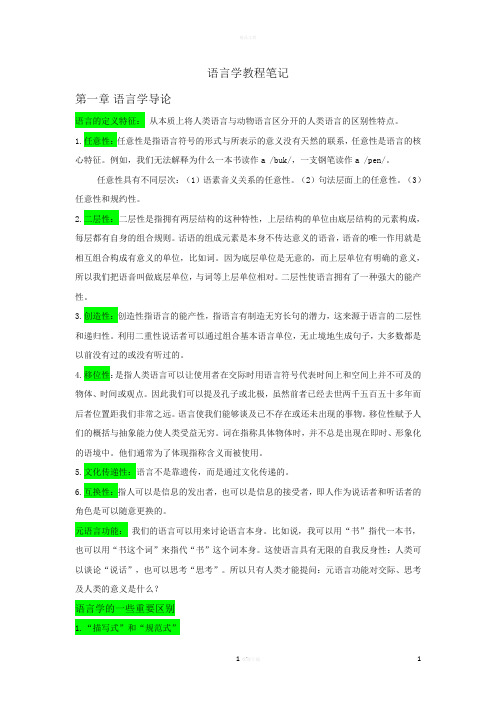
语言学教程笔记第一章语言学导论语言的定义特征:从本质上将人类语言与动物语言区分开的人类语言的区别性特点。
1.任意性:任意性是指语言符号的形式与所表示的意义没有天然的联系,任意性是语言的核心特征。
例如,我们无法解释为什么一本书读作a /buk/,一支钢笔读作a /pen/。
任意性具有不同层次:(1)语素音义关系的任意性。
(2)句法层面上的任意性。
(3)任意性和规约性。
2.二层性:二层性是指拥有两层结构的这种特性,上层结构的单位由底层结构的元素构成,每层都有自身的组合规则。
话语的组成元素是本身不传达意义的语音,语音的唯一作用就是相互组合构成有意义的单位,比如词。
因为底层单位是无意的,而上层单位有明确的意义,所以我们把语音叫做底层单位,与词等上层单位相对。
二层性使语言拥有了一种强大的能产性。
3.创造性:创造性指语言的能产性,指语言有制造无穷长句的潜力,这来源于语言的二层性和递归性。
利用二重性说话者可以通过组合基本语言单位,无止境地生成句子,大多数都是以前没有过的或没有听过的。
4.移位性:是指人类语言可以让使用者在交际时用语言符号代表时间上和空间上并不可及的物体、时间或观点。
因此我们可以提及孔子或北极,虽然前者已经去世两千五百五十多年而后者位置距我们非常之远。
语言使我们能够谈及已不存在或还未出现的事物。
移位性赋予人们的概括与抽象能力使人类受益无穷。
词在指称具体物体时,并不总是出现在即时、形象化的语境中。
他们通常为了体现指称含义而被使用。
5.文化传递性:语言不是靠遗传,而是通过文化传递的。
6.互换性:指人可以是信息的发出者,也可以是信息的接受者,即人作为说话者和听话者的角色是可以随意更换的。
元语言功能:我们的语言可以用来讨论语言本身。
比如说,我可以用“书”指代一本书,也可以用“书这个词”来指代“书”这个词本身。
这使语言具有无限的自我反身性:人类可以谈论“说话”,也可以思考“思考”。
所以只有人类才能提问:元语言功能对交际、思考及人类的意义是什么?语言学的一些重要区别1.“描写式”和“规范式”描写式:客观系统地记录一种语言的模式和用法或变化。
- 1、下载文档前请自行甄别文档内容的完整性,平台不提供额外的编辑、内容补充、找答案等附加服务。
- 2、"仅部分预览"的文档,不可在线预览部分如存在完整性等问题,可反馈申请退款(可完整预览的文档不适用该条件!)。
- 3、如文档侵犯您的权益,请联系客服反馈,我们会尽快为您处理(人工客服工作时间:9:00-18:30)。
第十一章语言学与语言教学复习笔记I.应用语言学的定义从广义上讲,应用语言学是对语言、语言学与语言相关的问题的研究,例如词典编纂学,翻译等。
应用语言学运用来自语言学的信息来发展它自身理论模块部分,例如教学大纲设计,言语治疗,语言规划,文体学等。
从狭义上讲,应用语言学是指对第二语言和语言教学的研究,例如研究语言和语言学与语言教学的关系。
II.语言学与语言教学的关系语言教学是应用语言学的一个部分,而应用语言学又是语言学的一个分支。
掌握一些语言学的知识不仅有助于这些读者进一步认识语言本质,也有助于他们更加深入地理解如何教好语言。
语言学理论直接地或间接地影响着语言教学的途径和方法。
Ⅲ.语言学与语言学习许多语言学习理论都是基于某种语言学理论提出的。
事实上,语言学知识能够使我们真正理解学习者能够学习什么样的语言,怎样学习语言以及最终能够学到什么。
因此,语言学在语言习得研究和语言学习研究中一直起着十分重要的作用。
1.语法与语言学习很多传统的语言教师将语法割裂为孤立的语法知识点来分别讲解,这种做法已经受到广泛的批评,因为它仅仅关注语言形式而忽略了语言的意义。
作为“完全以语言形式为中心”和“完全以语言意义为中心”的折中途径,近年来出现的“关注语言形式” (focus on form)对语言学习中语法的作用采取了一种折中的态度。
主要有两个变量影响语言成分在“关注语言形式”中的顺从性,即普遍语法(UG)的相关度和语言结构的复杂度。
“关注语言形式”的支持者们认为,如果二语中的某个结构是普遍语法的一部分,它的顺从性就高;否则,顺从性则低。
在“关注语言形式”的教学中,我们会根据语言结构顺从性的高与低来采取不同的措施。
2.输入和语言学习当学习者接受了足够的目的语输入时,语言学习自然而然就会发生。
输入可以是口头语言,也可以是书面语言。
口头语言输入可能发生在交互活动中 (即如学习者与母语者、教师或者是其他学习者的对话),或者出现一个没有交互的语境中 (例如听音乐或者看电影)。
(1)真实性输入那些更强调意义的语言教学者主张提供真实性输入。
即输入要与现实生活紧密相连,这种输入通常忽略语法。
(2)可理解的输入可拉申的语言输入假说认为,学习者掌握语言是理解了输入的结果。
他提出了“i+1”的概念:学习者所接触到的语言应该和学习者的水平保持一定的距离,大部分的内容可以理解但仍然有一些对他们来说是具有挑战性的。
输人对学习者来说,既不应该太难也不应该太容易。
虽然输入在语言学习中的作用是不言而喻的,但输入理论及其应用仍然有很多问题值得研究。
问题之一就是我们对不同的输入类型还缺少语言学的分析。
不同类型的语言输入很有可能对语言学习产生不同效果,但是我们并不知道不同的输入在语言上究竟有哪些区别。
3.中介语和语言学习正处于学习过程的二语或外语学习者构建的语言通常被称为中介语。
中介语通常被理解为介于目的语和学习者母语之间的语言。
与目的语相比,中介语还不够完善,但它也不只是学习者母语的简单翻译。
我们也不能把中介语看成是母语和目标语的过渡阶段或者是二者的简单混合。
中介语是一个动态的语言系统,它不断地从初级水平向地道的母语水平发展。
Ⅳ.语言学与语言教学可以说语言教学的方方面面都可以从语言学中获得启示。
从宏观上看,语言学理论影响着教学法的总体发展方向。
从微观上看,语言学知识能帮助教师更好的解释他们所教语言知识的细节。
1.基于语篇的语言教学(1)以语篇为基础的语言观认为,语言范式存在于语篇之中。
以语篇为基础的语言观关注的是口头和书面的完整语篇以及这些语篇所在的社会和文化背景。
(2)基于语篇的语言教学强调培养学习者的语篇能力,这是与众所周知的交际能力很相近的一种能力。
交际能力是指学习者在具体的语境中恰当并且有效的运用语言进行交际的能力。
交际能力包括语法词汇知识、会话规则以及怎样运用和回答不同类型的言语行为和社会习俗,以及怎样恰当得体地运用语言。
(3)基于语篇的语言教学观还有很多不足之处,因此受到人们的批评。
它过分强调了语言习得过程中的外部因素,而没有对内部因素给予足够的重视。
它与行为主义语言习得观有一个共同之处,即把环境因素和语言输入视为语言习得的核心。
它过于关注语言习得中学习能力和语言功能的作用,却没有注意到指导语言习得的一些普遍规律。
2.普遍语法与语言教学(1)普遍语法要回答的一个主要问题是为什么第一语言习得可以基于很少的外界输入而能快速获得成功。
普遍语法认为语言习得本质上并不依靠外在的语言输入。
(2)根据乔姆斯基的观点,每一个母语者都具有一种语言能力。
孩子出生时就具有一些带有普遍性的语言知识。
在母语习得过程中,人们不断把先天这种内在的语言体系与母语相比较,从而调整自己的语法结构。
因此,语言学习不是一个简单的习惯形成过程,而是一个不断地建立和验证假设的过程。
(3)基于普遍语法的语言教学理论也受到了人们的批评。
普遍语法是专门为了解释语言的运作方式而提出来的。
然而,为了解释语言本身,普遍语法支持者也必须研究语言习得的过程。
但有关语言习得的论述在普遍语法理论中只是次要的。
普遍语法的第二个不足在于它只关注英语句法的核心语法和通用的规则。
第三,语言最重要的功能在于交际,但是这一点被普遍语法忽略掉了。
(4)普遍语法在解释中介语的发展和母语的影响等方面做出了重要的贡献。
在语言教师 (或教育语言学家)如何开展进行词汇教学和语法教学这个问题上,普遍语法提供了重要的信息。
然而另一方面,还没有确凿的证据来支持普遍语法的存在。
V.教学大纲设计教学大纲的设计在语言教学中有着举足轻重的地位。
从某种意义上说,大纲设计是联系教学理论和教学实践的桥梁。
教学大纲把教学理论应用到教学实践之中并且为实践建立了一个可操作的框架。
设计教学大纲最重要的部分是选择和安排教学内容。
1.教学大纲和课程计划(1)教学大纲用来指教室中具体发生的活动,通常包括教学的目标和内容,有时也指教学方法。
而课程计划所提供的原则是:对语言理念,语言学习和语言教学的基本原理的概括;对教学目的和目标的具体说明;教学计划的具体实施。
从某种意义上说,教学大纲是实施课程计划的一部分。
(2)另一点是大纲经常用来指称和语言教学途径非常相似的概念,而课程计划则指为某国家或地区的语言课程所设计的具体文件。
2.教学大纲设计的理论背景外语教学中大纲设计过程主要包括选择和排列教学内容。
选择的过程包括两个步骤:首先,把语言限定在某个特定的方言和语域内。
第二,根据一定的标准,例如出现的频率、难易度或者课堂需求等,从所选语境中进一步选择要学习的语言。
整个的过程应该在语言的所有层次上进行,例如语音、语法、词汇、语境 (语义或文化的)。
3.教学大纲类型(1)结构教学大纲结构主义大纲主要以语法教学为导向,以语言结构为基础。
语法大纲潜在的理念是把语言看作一系列由语法规则组成的体系;学习语言就是要学习这些规则并且把这些规则应用到实际语言运用中。
结构教学大纲的主要缺点在于它注重语法形式和单个词语的意思,认为不论是在什么语境下整句话的意思都是显而易见的。
它没有教授学生们如何在真实的语境下使用这些句子。
因此,经过结构教学大纲训练出来的学生通常是缺乏实际交际能力的。
(2)情景教学大纲情景教学大纲没有坚实的语言学理论基础。
我们可以认为情景教学大纲的编写者们视语言为一种交际工具。
编写情摄大纲的目的是要具体区分目的语使用的不同场景。
语言的选择和组织都是以情景为线索的。
相比之下,情景教学大纲比结构教学大纲更具有优势,因为它开始关注了学习者:卣接的交流需要。
然而,情景式大纲要依附于已有的语言观,而现在这个语言观仍然是结构主义的,因此从本质上看,情景式大纲仍然是以语法为主线的。
另外,这些情景的组织安排也没有什么系统性可寻。
(3)交际教学大纲交际教学大纲的目的是培养学生的交际能力。
它以功能一意念大纲为基础,它教授表达和理解不同语言功能时所需要的语言,并且强调交际的过程。
(4)任务型教学大纲任务型教学大纲更加关注激发学习的课堂学习过程,而不是学生所要掌握的语言知识和技能。
这些教学大纲对于课堂上学习者所进行的任务和活动列出了说明。
4.教学大纲设计的现行趋势(1)新旧并存虽然过去三十年里提出了许多不同类型的教学大纲,但是目前传统的教学大纲 (如语法教学大纲和词汇教学大纲)还没有完全被摒弃,较新的模式 (如内容教学大纲和任务型教学大纲)还没有被普遍接受。
(2)强调学习过程与传统的教学大纲相比,较新的模式 (如内容教学大纲、程序教学大纲和任务型教学大纲)更关注语言学习的过程,而不是语言学习的结果。
(3)大纲中包含非语言目标与传统的教学大纲相比,新的大纲通常包括一系列非语言目标,例如学习策略和情感态度的培养。
(4)多元大纲的出现综合性的教学大纲也称作多元教学大纲。
设计多元教学大纲并不是简单地把不同类型大纲中的要素拼凑在一起,而是优先考虑哪些内容。
Ⅵ.对比分析和错误分析对母语作用的研究通常被称作语言迁移研究,语言迁移指先前学习的心理过程转移至新的学习环境,或者指“由于目的语与先前(可能不完全)习得的其他任一门语言之间的异同所导致的影响”。
1.对比分析对比分析是通过对比不同语言(如第一语言和第二语言)来确定潜在错误的方法,从而把第二语言学习环境下必须学习的和不必学习的东西最终区分开来。
对比分析的目的是为了预测哪些领域容易学得,哪些领域不易学得。
早期的对比分析与行为主义和结构主义相关。
2.错误分析并非所有的错误都可以由对比分析进行解释,这使得人们对对比分析不再抱有过大的希望。
对比分析逐渐被错误分析所取代,除了第一语言的影响外,还有其他因素的影响。
(1)错误与失误错误分析的文献中经常要区分错误 (error)和失误 (mistake)这两个概念。
错误通常是由于学习者知识不足所致。
换言之,由于学习者不知道正确的形式或者不能正确地使用语言而出现的错误。
失误则是由于学习者没能发挥出自己的能力而出现差错。
也就是说,学习者学会了某种知识或技能,但是由于不注意或者其他因素的影响而没能正确地使用语言。
(2)不同类型的错误①语际错误与语内错误根据错误来源,错误经常分为语际错误和语内错误。
学习者由于误用与母语有共同特征的语言项目而产生的错误叫语际错误 (或迁移错误)。
语内错误是在目的语内部所犯的错误 (也称为发展性错误)。
例如,将某一规则扩展到超出其使用的范围而造成的过度概括。
②省略、添加、双重标记、形式错误和顺序错误根据错误性质,错误经常可以被划分为五种类型:省略、添加、双重标记、形式错误和顺序错误。
3.错误分析的步骤(1)识别错误如果语言学习者所使用的句子不合乎语法,那就会产生错误。
如果句子语法正确但在交际情景下使用不恰当,那就会产生失误。
(2)描述错误可以通过把错误与操母语者造出的句子相比较来发现错误。
